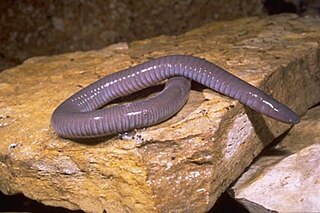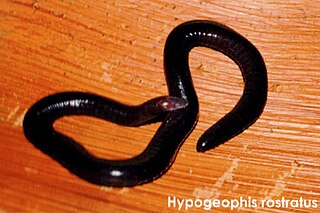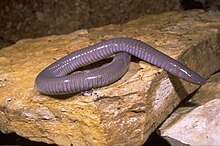Dermophis costaricense is a species of caecilian in the family Dermophiidae. It is endemic to Costa Rica and is found on the Atlantic versant of Cordillera de Tilarán, Cordillera Central, and Cordillera de Talamanca. Its taxonomic status is in need of a review.

Dermophis is a genus of worm-like amphibians in the family Dermophiidae, the Neotropical and Tropical African caecilians. They are found in the Middle America between southern Mexico and northwestern Colombia. Common names Mexican caecilians or Neotropical caecilians are sometimes used for them.
Dermophis gracilior is a species of caecilian in the family Dermophiidae. It is found on the Pacific slopes of Cordillera de Talamanca in eastern Costa Rica and western Panama, as well as in the central Pacific Costa Rica. Some sources also report it from the Atlantic slope of Costa Rica.

Dermophis mexicanus, also known commonly as the Mexican burrowing caecilian or the Mexican caecilian, and locally as the tapalcua or tepelcua, is a species of limbless amphibian in the family Dermophiidae. The species is native to Mexico and Central America, where it burrows under leaf litter and plant debris.
Dermophis oaxacae, also known Oaxacan caecilian, is a species of caecilian in the family Dermophiidae. It is endemic to southwestern Mexico and occurs on the Pacific slopes and the Balsas depression in the states of Jalisco, Michoacán, Guerrero, Oaxaca, and Chiapas.
Dermophis occidentalis is a species of caecilian in the family Dermophiidae. It is endemic to south-western Costa Rica and occurs in the Pacific lowlands and premontane slopes, extending to the western part of the central valley. Its taxonomic status is unclear.

Dermophis parviceps is a species of caecilian in the family Dermophiidae. It is found in Costa Rica and Panama, and possibly in Colombia, depending on the source. Common names slender caecilian and La Loma caecilian have been coined for it.

Geotrypetes is a genus of caecilians in the family Dermophiidae, although some classifications place it in the family Caeciliidae. They occur in tropical West Africa and are sometimes known as the West African caecilians.
Geotrypetes pseudoangeli is a species of caecilian in the family Dermophiidae. It is only known from Sanokwelle near Ganta in northern Liberia and from Beyla in southeastern Guinea. Common name false Angel's caecilian has been suggested for this species.

Geotrypetes seraphini, the Gaboon caecilian, is a species of amphibian in the family Dermophiidae. It is found in Cameroon, Democratic Republic of the Congo, Ivory Coast, Equatorial Guinea, Gabon, Ghana, Guinea, Liberia, Nigeria, Sierra Leone, and possibly Angola, and the Republic of the Congo. Its natural habitats are subtropical or tropical moist lowland forests, plantations, rural gardens, urban areas, heavily degraded former forests, and seasonally flooded agricultural land.

Gymnopis multiplicata is a species of caecilian in the family Dermophiidae found in Costa Rica, Honduras, Nicaragua, Panama, and possibly Guatemala. Its natural habitats are subtropical or tropical dry forests, subtropical or tropical moist lowland forests, subtropical or tropical moist montane forests, pastureland, plantations, rural gardens, and urban areas.
Gymnopis syntrema is a species of caecilian in the family Dermophiidae. It is found in Belize, Guatemala, and possibly Honduras. Its natural habitats are subtropical or tropical moist lowland forests, subtropical or tropical moist montane forests, plantations, rural gardens, and heavily degraded former forest. It is threatened by habitat loss.
Schistometopum gregorii, also known as Witu caecilian, mud-dwelling caecilian, and flood-plain-dwelling caecilian, is a species of amphibian in the family Dermophiidae from East Africa.

The Siphonopidae are the family of common caecilians. They are found in Central and South America. Like other caecilians, they superficially resemble worms or snakes.

The Grandisoniidae are a family of common caecilians found in Africa, Seychelles and India. Like other caecilians, they superficially resemble worms or snakes. The family was formerly known as Indotyphlidae.
Dermophis donaldtrumpi is a name proposed for a putative new species of caecilian – a nearly-blind, serpentine amphibian – to be named after Donald Trump. It was originally discovered in Panama and though the name was proposed in 2018, it has yet to be confirmed as a new species; as of 2022, the binomial name and description of the species has not been formally published. It was given its name after the Rainforest Trust held an auction for the naming rights. The company EnviroBuild won the auction and proposed naming the species in protest against Trump's environmental policies and views.






